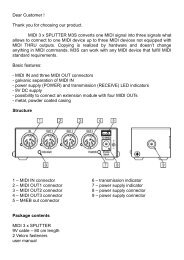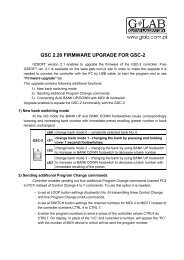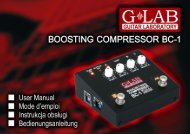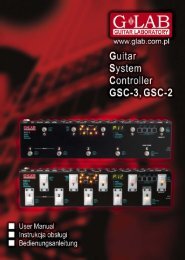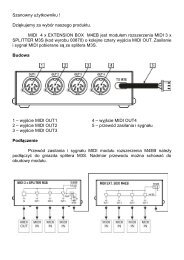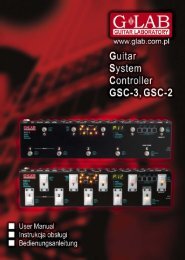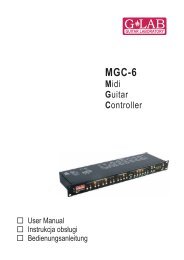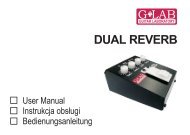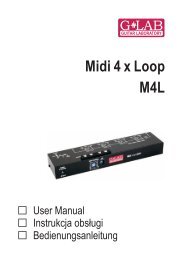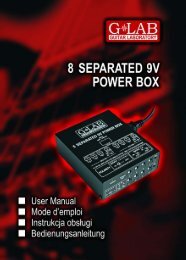G LAB Dual Vintage Overdrive Double satisfaction
G LAB Dual Vintage Overdrive Double satisfaction
G LAB Dual Vintage Overdrive Double satisfaction
Create successful ePaper yourself
Turn your PDF publications into a flip-book with our unique Google optimized e-Paper software.
Szymon Kwiatkowski<br />
G <strong>LAB</strong> <strong>Dual</strong> <strong>Vintage</strong> <strong>Overdrive</strong><br />
<strong>Double</strong> <strong>satisfaction</strong><br />
I have to admit I’m more<br />
and more satisfied with<br />
marketing activities of G<br />
<strong>LAB</strong> brand. Maybe we can<br />
just observe the first steps<br />
of Polish guitar electronics<br />
manufacturer aiming<br />
to conquer the worldwide<br />
market? I mean not only<br />
that the mother of this<br />
brand, ELZAB company, is<br />
listed on the Warsaw Stock<br />
Exchange but first of all<br />
the huge dose of innovation<br />
and well-considered<br />
design of this equipment.<br />
This positive technical<br />
idea is going together with<br />
well-considered promotion<br />
- large scale presentation<br />
of the products to the musical<br />
environment.<br />
GUITAR EFFECT<br />
Last year we’ve observed debut of the Guitar<br />
System Controller together with the Wah-Pad,<br />
now we can acquire the new device. The GSC is a<br />
device focused on helping a guitar player to control<br />
his stompboxes collection, specially during playing<br />
concerts. The next step and product is the G <strong>LAB</strong><br />
<strong>Dual</strong> <strong>Vintage</strong> <strong>Overdrive</strong>. We find at this device given<br />
function creating a guitar tone. But what is important<br />
and typical for G “<strong>LAB</strong>oratory” products – they<br />
haven’t forgot the extension of connectivity to an<br />
amp options and connections with external modules.<br />
Will we check what is the matter?<br />
Four blocks<br />
The <strong>Dual</strong> <strong>Vintage</strong> <strong>Overdrive</strong>, in spite of its name,<br />
is generally the three channel device. And it doesn’t<br />
concern to three footswitches on the top panel of<br />
the device however in this case it is the right indication.<br />
More important is that beside two <strong>Overdrive</strong><br />
channels on which the concept of the device<br />
is based, we can use the “clean” channel which<br />
works as a preamp, introducing delicate vintage<br />
tone to our amp. The construction is very similar to<br />
the GCS. We’ve got here solid, one millimetre metal<br />
sheet casing and monochrome colouring – white<br />
colour controls and backlighted footswitches. Descriptions<br />
are also white painted so the legibility<br />
is out of questions. Distinctive are four blocks on<br />
the effect top panel: clean channel, equalizer, overdriven<br />
channel first and second. However you can’t<br />
treat them in the same way. Except of the equalizer<br />
which allows to adjust the tone almost in each<br />
configuration, you can set two functions to each of<br />
three footswitches. To configure whole device are<br />
used four DIP switches hidden inside side partition<br />
of the casing. Using a ballpen (we don’t suspect guitar<br />
players of having so long nails) we set settings<br />
we are interested in. How the particular settings<br />
are working is shown on the attached diagrams<br />
(Fig. 1-4). The effect can work as a traditional overdrive,<br />
boosting the signal up to the overdrive level<br />
with clean channel or solo boost working mode, as<br />
well as a guitar preamp with three working modes<br />
(three footswitches).<br />
<strong>Overdrive</strong> or preamp?<br />
I think that considering all its features the name<br />
<strong>Dual</strong> <strong>Vintage</strong> <strong>Overdrive</strong> is not proper and the last<br />
word I would change to Preamp word. The overdrive<br />
characteristics, we will return to this issue later, is<br />
typical for OD or Fuzz devices, so is based on (at<br />
least in hearing sphere, not necessarily in design)<br />
strong exceeding of allowed amplitude. More it deserves<br />
the preamp name for the reasonably wide<br />
range of gain which is different for selected channel<br />
settings and which can be smoothly controlled<br />
by a potentiometer or boosted by the dedicated<br />
MARCH/APRIL 2008<br />
footswitch. Such solution has got some advantages.<br />
The first, and considered as the most important, is<br />
to receive vintage effect tone, resembling early LED<br />
ZEPPELIN or DEEP PURPLE songs, being associated<br />
with a speaker overdriving, or even broken from<br />
its elastic fitting membrane when a GAIN potentiometer<br />
gives full overdriving. The second advantage,<br />
also important, is ability to strong saturate<br />
a preamp while using a tube amp for playing. The<br />
value of such usage is higher amount of harmonics<br />
emitted by a tube which is strong saturated by a<br />
signal. So the DVO functioning as a preamp is still<br />
important, specially that it can be set in such way<br />
to supply different levels of gain. For configuration<br />
is used mentioned inconspicuous DIP switch at the<br />
opening of the left side of the casing. Hidden but<br />
how important! Additionally using on board equalizer<br />
we set our preferable tone. The adjustment<br />
range will not down your but is sufficient for the<br />
non tube device. So we can see that there adds the<br />
attribute of G <strong>LAB</strong> products – great number of settings<br />
and applications as well as variety of possible<br />
connections.<br />
How to connect?<br />
To use this device in the traditional way enough<br />
is to connect it between a guitar and an amp then<br />
set any working mode of footswitches. You connect<br />
it to an amp serially or parallel using an amp’s loop.
GUITAR EFFECT<br />
Working mode No. 1<br />
Working mode No. 2<br />
The design style of <strong>Dual</strong><br />
<strong>Vintage</strong> <strong>Overdrive</strong> is similar<br />
to the previous G <strong>LAB</strong><br />
product – Guitar System<br />
Controller.<br />
Working mode No. 3<br />
Fig. 1-4. Operations of particular modes of working.<br />
And another curious detail - special switching cable<br />
for parallel work with an amp. G <strong>LAB</strong> is manufacturing<br />
these cables and I think that buying such a<br />
one should be a good idea! In this way we connect<br />
using just one cable SEND/RETURN amp loop sockets<br />
with OUT DVO output, and clean guitar signal we<br />
supply from the PRE OUT DVO output directly to<br />
an amp input. Independence of an amp tones from<br />
overdriven DVO channels is the advantage of such<br />
solution. Tones from DVO are independent from an<br />
amp tone settings (except of PRESENCE control if<br />
available). Interesting way of using a loop however<br />
OD type effect connected to a loop seems to be a<br />
guitar blasphemy. Despite of that you can tempt<br />
yourself into using this stompbox as the preamp<br />
for additional colourisation of the signal pre power<br />
amp. Connecting with the GSC and connecting with<br />
a tuner using silent tuning function are just typical<br />
conveniences installed by G <strong>LAB</strong>.<br />
Working mode No. 4<br />
This is vintage!<br />
So what we can hear after connecting the <strong>Dual</strong><br />
<strong>Vintage</strong> <strong>Overdrive</strong>? Construction and electronic<br />
solutions suggest modern tone met now commonly<br />
everywhere. And you’re mistaken - vintage is vintage!<br />
Adjusting the GAIN even to the maximal level<br />
we can hear the tone rich of harmonics with strong<br />
“smooth” characteristics. The effect is interesting,<br />
you can try to use it in ambient type music. This<br />
is available at maximal set overdrive. The ideal<br />
setting for the first and the second channel is the<br />
beginning part of the range. At this setting you will<br />
hear blues taste, and at high signal converters -<br />
dynamic crunch. Very nice increases sensitivity to<br />
your articulation and dynamics of your playing<br />
ideally relates to the effect which obey it in this<br />
way of overdrive controlling. Sensitive to the force<br />
of playing and string hits level of initiation allows<br />
to adjust the overdrive adequately. It is not really<br />
controlling the overdrive level by the force of hitting<br />
the string but something very similar. The DVO<br />
is sensitive. It offers solo boost assigned to No. 3<br />
footswitch and two gain boosts for each channel.<br />
Absolutely not bad! The interesting function of the<br />
equalizer should be noticed. The equalizer works independently<br />
from set mode of working. It changes<br />
the tone even of the clean channel! And BASS and<br />
TREBLE controls have been enriched by 3 dB boosts<br />
post overdriving. In this way we can modify our<br />
tone in a contour style which is preferred to be used<br />
while playing with an overdrive effect.<br />
Summarisation<br />
The first appointment with the <strong>Dual</strong> <strong>Vintage</strong> <strong>Overdrive</strong><br />
can be a tough job. To set the working mode<br />
will require to look at the manual or at the label<br />
on the bottom of the effect, however similar to the<br />
GSC – setting the equipment according to preferences<br />
is done “ones and properly”. According to<br />
the tone the effect will meet with requirements of<br />
musicians searching slightly or medium overdriven<br />
tone. There are good sounding blues accords, rock<br />
triple sound riffs and blues solo playing. The tone<br />
is performed rather more at treble and middle, to<br />
receive more bass it will need more “plus” correction<br />
at your amp equalizer. But do not forget that<br />
DVO is vintage – and the tone should be like this.<br />
You can like such combination of the modern<br />
technology with the traditional „manners”.<br />
Price:<br />
Producer:<br />
MARCH/APRIL 2008



